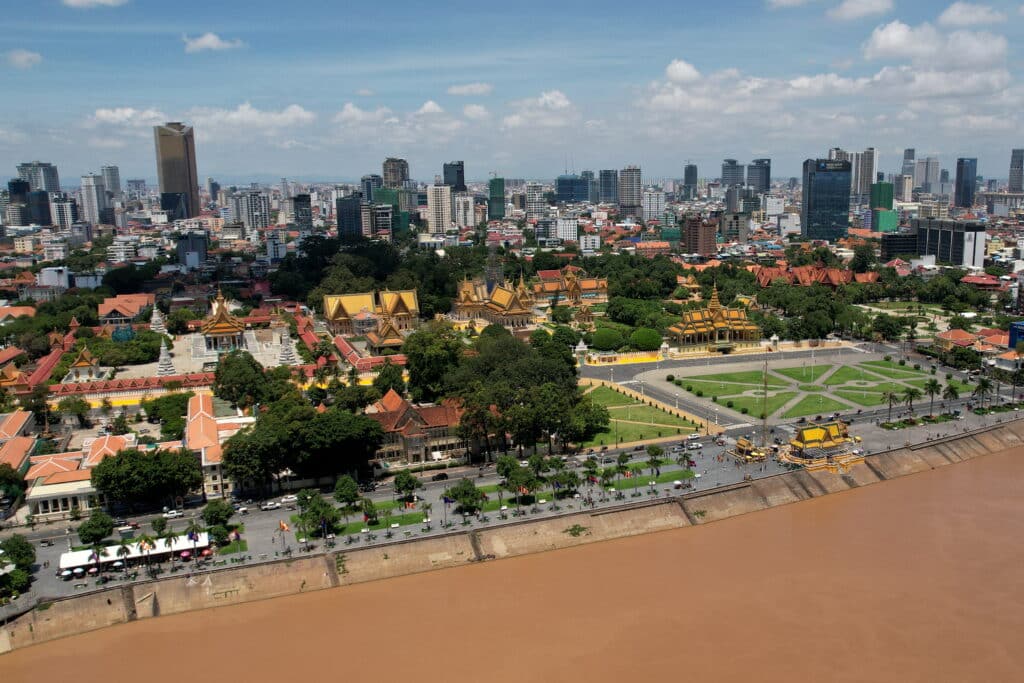By Yunkang Liu
After taking office in August 2023, Prime Minister Hun Manet launched an ambitious US$1.7 billion waterway project known as the Funan Techo Canal, designed to connect Phnom Penh to the coast through Kep province some 180 kilometres away. Cambodia hopes to reduce dependence on trade routes controlled by Vietnam along the Mekong River and demonstrate its resolve to pursue national development interests.
The Funan Techo Canal is central to Cambodia’s aspirations to become a major logistics and economic hub in the Mekong sub-region and a key driver of the country’s economic growth. The proposed waterway is 100 meters wide and 5.4 meters deep, capable of accommodating cargo ships of up to 3000 deadweight tons. With this canal, Cambodia will cut shipping through Vietnam by 70 per cent and expect to earn US$88 million annually from transportation by 2050.
Some analysts believe that this project can promote the country’s economic development by facilitating the transport of finished products and generating as many as 1.6 million jobs in the process. Additionally, the canal project could revolutionise water resource management in Cambodia, boosting the growth of the agricultural sector and enhancing flood control and water conservation efforts.
One perspective suggests that Cambodia’s need for this canal is rooted in its historical memory, particularly the economic blockade imposed by the South Vietnamese government in 1956 by weaponising Cambodia’s dependence on the port of Saigon. This has driven Cambodia to pursue strategic autonomy over the years.
In September 2023, the China Bridge and Road Corporation signed an agreement with Cambodia to invest in the canal project via a Build-Operate-Transfer contract. The new canal will facilitate access to Cambodia’s Sihanoukville Special Economic Zone and its port, which has received significant investment through China’s Belt and Road Initiative.
Vietnam has articulated concerns about how the Funan canal may impact its own port traffic as well as affect the ecosystem and natural balance along the Mekong River. Phnom Penh will likely have to assure its neighbours that the canal project abides by the 1995 Mekong Agreement and the regulations of the Mekong River Commission.
Strategic analysts in Washington meanwhile believe the canal could be leveraged to reinforce China’s military presence in Southeast Asia. The canal’s outlet near Cambodia’s Ream Naval Base could present future security challenges in the region. Another concern is whether the construction of the project would increase Cambodia’s economic dependence on China and potentially translate into political influence, China undertakes for the canal construction may prompt Cambodia to support China on regional and international issues, including South China Sea disputes involving Southeast Asian countries like Vietnam.
Hun Sen has dismissed these concerns as unfounded conspiracy theories. The government further stated that China did not instruct Cambodia to construct the Funan Techo Canal but that Phnom Penh sought support from Beijing.
There is no strong evidence to prove that the canal would increase China’s military presence in Southeast Asia. The project will pose a security threat to region are wildly overblown, as Article 53 of Cambodia’s Constitution stipulates a policy of permanent neutrality and non-alignment and does not allow the establishment of any foreign military bases.
The canal project’s construction will likely test Prime Minister Hun Manet’s foreign policy and diplomatic acumen and management of Cambodia’s relationship with Vietnam and potentially other major powers. He may further be tested on his capacity for governance and strategic foresight in managing potential issues such as community resettlement and environmental impacts along the canal domestically.
Given the intricate relationships among the project’s stakeholders and the ever-evolving geopolitical landscape in the Mekong region, discussions surrounding the project are becoming increasingly securitised and politicised. The Funan Techo Canal project has revealed an undercurrent of competing interests is surging in Southeast Asia.
As a sovereign nation, Cambodia has the right to pursue development projects within its territory, while its neighbour Vietnam has the right to express its concerns based on its own interests. As many advocate, Cambodia and Vietnam should work towards mutual understanding and conflict management, a proposition that Hanoi seems to support. But the discourse surrounding the Funan Techo Canal project is unlikely to ebb anytime soon, as discussions currently extend beyond just Cambodia and Vietnam and involve a range of stakeholders.
The Funan Techo Canal project will likely lead to further discussion on Thailand’s ‘Land Bridge’ project, described as an ‘alternative route’ to the Malacca Strait that has sparked wide discussion about the relationship between Thailand, Singapore and Malaysia. China is one of the potential investors of the ‘Land Bridge’ project and it should recognise the need to be more cautious and prioritise risk management when funding large-scale overseas infrastructure projects. This vigilance is especially important in the complex and ever-changing geopolitical environment of Southeast Asia.
The canal and related issues present a potential opportunity for the Association of Southeast Asian Nations (ASEAN) to mediate and reduce tensions. Cambodia chaired ASEAN as recently as 2022 and the organisation is home to a majority of stakeholders affected by the project.
Yunkang Liu is PhD student in Politics and International Relations at the School of Social Sciences, the University of New South Wales, Sydney.
